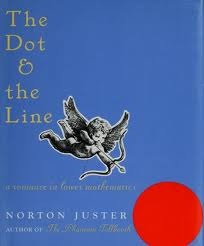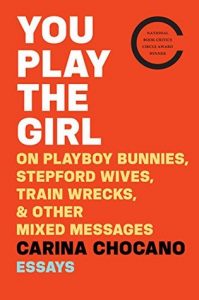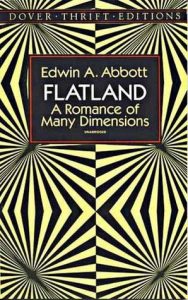 The Dot & the Line: A Romance in Lower Mathematics by Norton Juster is absolutely delightful, featuring a love triangle between a “sensible straight line who was hopelessly in love with a dot”, who was of course hanging out with “a wild and unkempt squiggle”. Accompany your reading with the short animated film on YouTube (and apparently also as a special feature in The Glass Bottom Boat DVD, of which we own 3 copies, so feel free to check that out).
The Dot & the Line: A Romance in Lower Mathematics by Norton Juster is absolutely delightful, featuring a love triangle between a “sensible straight line who was hopelessly in love with a dot”, who was of course hanging out with “a wild and unkempt squiggle”. Accompany your reading with the short animated film on YouTube (and apparently also as a special feature in The Glass Bottom Boat DVD, of which we own 3 copies, so feel free to check that out).
The overall structure of the plot arc is quite predictable, but that’s not where the charm of this wonderful romance lies. Part of it, I’m sure, is just in the fact that it was written in the 60s, so some of the phrasing is a touch quaint reading it now, but I want to say that the charm of it is simply in the fact that this is a mathematical romance. It’s dedicated to Euclid! There are math puns & references everywhere (though some of them smarter than others), and the entire novel(la) is overall a delightful romp. And as some of you know, despite math not being anywhere near my forte, I have a love of it all the same. You don’t really learn anything about shapes or math in any way apart from how to creatively apply lines and shapes, but that’s why it’s a romance in lower mathematics, right?*
*Or is it a romance in lower mathematics in the sense that it’s a romance of the stereotyped lower class? The dot and the squiggle are kind of portrayed in a certain (disreputable) cast, and the upstanding straight line in quite another (namely, as a respectable gentleman). Let’s… move on.
To be perfectly honest, part of the whole dynamic of the romance irks me a bit, but this was published in 1963 and I don’t think it necessarily detracts from the whole, because it’s so obviously something from another time.
 Let me explain what I mean about the dynamic. The dot doesn’t really do anything: she (yes, of course the passive character that is the dot is female) is simply the prize to be won. She experiences no character growth, which to be honest parallels the lack of growth in the squiggle as well, though the squiggle is presented as someone – something? – that neither has room to grow nor applies himself to doing so, whereas the dot is already perfection, “the beginning and the end, the hub, the core and the quintessence”, as the line tells her right from the start. I’m probably paying a bit more attention to this pattern in which the story is the boy’s story – his journey to becoming a better version of himself to win the girl – only because I was very recently reading about this exact topic (i.e. consistently passive depiction of women in literature and popular media) in You Play the Girl: On Playboy Bunnies, Stepford Wives, Train Wrecks and Other Mixed Messages by Carina Chocano, which I’ll probably highlight another time. (You already know by that title it’s going to be a fun ride.) Most if not all the stories we’re exposed to as children featuring some form of boy and girl romance – like fairytales – follow this shape: it’s the boy’s journey that we follow, his achievements and growth; the girl simply waits to be saved, she doesn’t change throughout the story – the girl is eternal. (Do you see a parallel in the ideals that are held to women?) But I digress. What I meant to say is that this is intended as a children’s novel (though it works equally well as an all ages novel, considering the delight it’s inspired in adults I’ve shown this book to), and while I don’t think Juster necessarily simplified anything because it’s targeted at children, I do think the straightforward nature of the story arc reflects this.
Let me explain what I mean about the dynamic. The dot doesn’t really do anything: she (yes, of course the passive character that is the dot is female) is simply the prize to be won. She experiences no character growth, which to be honest parallels the lack of growth in the squiggle as well, though the squiggle is presented as someone – something? – that neither has room to grow nor applies himself to doing so, whereas the dot is already perfection, “the beginning and the end, the hub, the core and the quintessence”, as the line tells her right from the start. I’m probably paying a bit more attention to this pattern in which the story is the boy’s story – his journey to becoming a better version of himself to win the girl – only because I was very recently reading about this exact topic (i.e. consistently passive depiction of women in literature and popular media) in You Play the Girl: On Playboy Bunnies, Stepford Wives, Train Wrecks and Other Mixed Messages by Carina Chocano, which I’ll probably highlight another time. (You already know by that title it’s going to be a fun ride.) Most if not all the stories we’re exposed to as children featuring some form of boy and girl romance – like fairytales – follow this shape: it’s the boy’s journey that we follow, his achievements and growth; the girl simply waits to be saved, she doesn’t change throughout the story – the girl is eternal. (Do you see a parallel in the ideals that are held to women?) But I digress. What I meant to say is that this is intended as a children’s novel (though it works equally well as an all ages novel, considering the delight it’s inspired in adults I’ve shown this book to), and while I don’t think Juster necessarily simplified anything because it’s targeted at children, I do think the straightforward nature of the story arc reflects this.
 Apparently The Dot & the Line was inspired by Edwin A. Abbott’s Flatland: A Romance of Many Dimensions, a novel that introduces the reader to a two-dimensional world where men are lines and women dots and featuring… A. Square, the protagonist of the novel. It’ll introduce you to one-, two-, and three-dimensional worlds before kicking Square back to his two-dimensional home for the affront of thinking about the potential of visiting a four-dimensional world (what a notion!) – summary paraphrased from Goodreads.
Apparently The Dot & the Line was inspired by Edwin A. Abbott’s Flatland: A Romance of Many Dimensions, a novel that introduces the reader to a two-dimensional world where men are lines and women dots and featuring… A. Square, the protagonist of the novel. It’ll introduce you to one-, two-, and three-dimensional worlds before kicking Square back to his two-dimensional home for the affront of thinking about the potential of visiting a four-dimensional world (what a notion!) – summary paraphrased from Goodreads.
It’s available both as a book as well as a streaming audiobook (on Overdrive), if you’d like to see where the idea for The Dot & the Line came from.